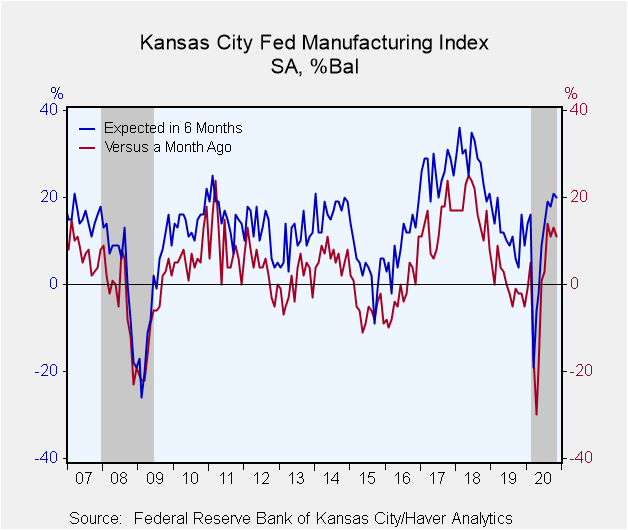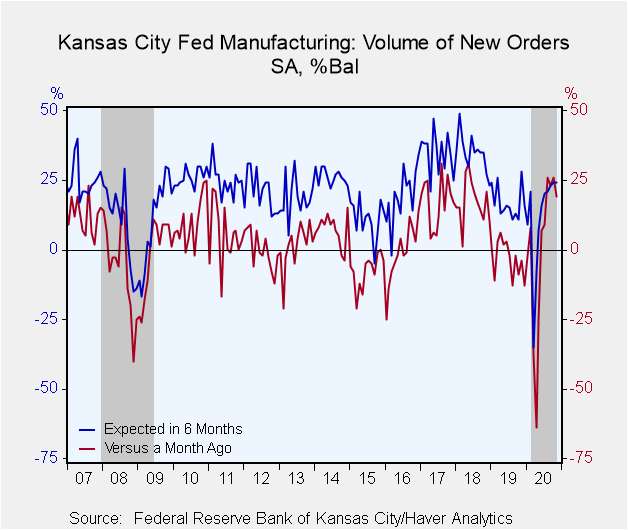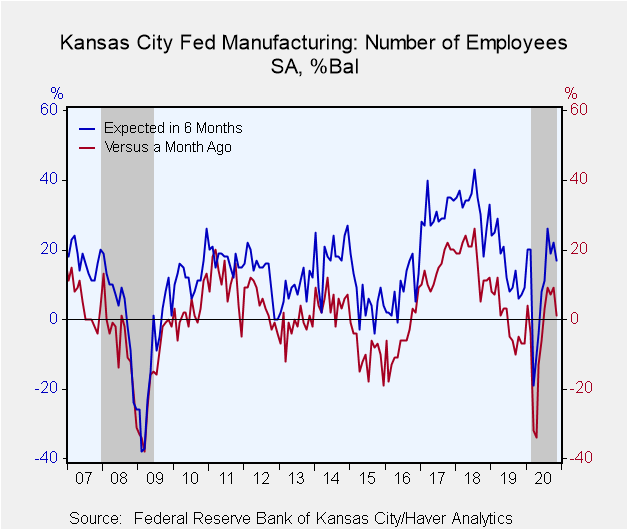 Global| Nov 19 2020
Global| Nov 19 2020Manufacturing Activity in Kansas City Fed District Slows in November
by:Sandy Batten
|in:Economy in Brief
Summary
• Growth continued though at a slower pace than in October. • Increases in orders, production and employment slowed. • Expectations for six months ahead also ebbed slightly. The Federal Reserve Bank of Kansas City reported that its [...]
• Growth continued though at a slower pace than in October.
• Increases in orders, production and employment slowed.
• Expectations for six months ahead also ebbed slightly.
The Federal Reserve Bank of Kansas City reported that its manufacturing sector business activity index slipped to 11 in November from 13 in October. The headline figure remained well above the all-time low of -30 posted in April.
The ISM-Adjusted Index (NSA) slipped to 53.9 in November from 56.2 in October, still well above the critical 50 level that separates expansion from contraction. It also remained well above the low of 37.6 in April
The slowdown in current conditions measures was relatively broad-based. New orders fell to 19, its lowest level since July. Production slipped to 20. Shipments and employment each plunged in November with shipments dropping to 3, its lowest reading since May, and employment falling to 1, its lowest reading since June.
On the inflation front, the prices received index for finished products rebounded some in November, rising to 7 after having fallen to 4 in October, though that remained up from the deflationary readings seen earlier this year. The raw materials index remained elevated at 32, down only slightly from its 34 reading in October. The October reading was the highest since November 2018.
The expectations-in-six months composite reading edged down to 20 in November from 21 in October though it remained up sharply from -19 in March. Expected new orders and production were unchanged in November. Expected shipments rose to 29, its highest reading since January 2018, while expected employment slipped.
Expectations of prices received rose to 30 in November from 26. Expectations of prices paid for raw materials fell to 50 in November from 55 in October, but the October reading was the highest since September 2018.
The composite index is an average of the production, new orders, employment, supplier delivery time and raw materials inventory indexes. The diffusion indexes are calculated as the percentage of total respondents reporting increases minus the percentage reporting declines. The November survey was conducted during the six-day period from November 10-16, 2020 and included 109 responses from plants in Colorado, Kansas, Nebraska, Oklahoma, Wyoming, northern New Mexico and western Missouri. Data for the Kansas City Fed Survey can be found in Haver's SURVEYS database.
| Kansas City Federal Reserve Manufacturing Survey (SA) | Nov | Oct | Sep | Nov'19 | 2019 | 2018 | 2017 |
|---|---|---|---|---|---|---|---|
| Conditions Versus One Month Ago (% Balance) | 11 | 13 | 11 | -2 | 0 | 17 | 14 |
| ISM-Adjusted Composite Index (NSA) | 53.9 | 56.2 | 54.9 | 49.4 | 50.0 | 58.9 | 56.7 |
| New Orders Volume | 19 | 26 | 23 | -4 | -3 | 17 | 17 |
| Number of Employees | 1 | 9 | 7 | -7 | -1 | 17 | 15 |
| Production | 20 | 23 | 18 | -2 | 2 | 19 | 17 |
| Prices Received for Finished Product | 7 | 4 | 12 | 3 | 7 | 22 | 7 |
| Expected Conditions in Six Months | 20 | 21 | 18 | 16 | 12 | 28 | 26 |
| New Orders Volume | 24 | 24 | 23 | 28 | 17 | 35 | 35 |
| Number of Employees | 17 | 22 | 19 | 7 | 15 | 33 | 39 |
| Production | 31 | 31 | 25 | 27 | 19 | 40 | 40 |
| Prices Received for Finished Product | 30 | 26 | 34 | 17 | 26 | 42 | 27 |
Sandy Batten
AuthorMore in Author Profile »Sandy Batten has more than 30 years of experience analyzing industrial economies and financial markets and a wide range of experience across the financial services sector, government, and academia. Before joining Haver Analytics, Sandy was a Vice President and Senior Economist at Citibank; Senior Credit Market Analyst at CDC Investment Management, Managing Director at Bear Stearns, and Executive Director at JPMorgan. In 2008, Sandy was named the most accurate US forecaster by the National Association for Business Economics. He is a member of the New York Forecasters Club, NABE, and the American Economic Association. Prior to his time in the financial services sector, Sandy was a Research Officer at the Federal Reserve Bank of St. Louis, Senior Staff Economist on the President’s Council of Economic Advisors, Deputy Assistant Secretary for Economic Policy at the US Treasury, and Economist at the International Monetary Fund. Sandy has taught economics at St. Louis University, Denison University, and Muskingun College. He has published numerous peer-reviewed articles in a wide range of academic publications. He has a B.A. in economics from the University of Richmond and a M.A. and Ph.D. in economics from The Ohio State University.










